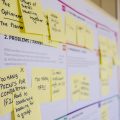A few years ago, it was normal for employees to stay in their jobs for many years, even for their entire lives. Today, however, the world of work has become much more dynamic. That is why retention and the pursuit of professional development have become critical to the success of any company.
One way that has proven to be very effective in achieving this is the implementation of individual career plans that guide employees in their professional growth. But it is not enough to simply sign employees up for a course. Designing a career plan is much more than that. For this reason, in this article you will discover how to create a career plan that builds employee loyalty and growth. A career plan that works.
What is a career development plan?
A career development plan is not just a professional roadmap. A career development plan is a structured framework that accompanies and guides employees in their development and growth within the company. Designing a career development plan is a strategic move that involves identifying professional goals, planning the steps to achieve them and allocating the necessary resources to facilitate their fulfillment.
If you are hesitating about whether it is worth making a career development plan for employees let us qualify one issue. In addition to a strategic move, creating a career plan is a mutual commitment between the company and the employee to pave the way for professional development. It is a partnership pact in which there are various benefits for both parties.
The importance of a career development plan for career growth
Career development plan benefits for employees:
- Clarity and direction at work: this is perhaps the most tangible benefit of a career development plan for employees. Knowing where they are headed professionally, how to achieve their goals and feeling supported along the way reduces any uncertainty they may have about their work. This alone gives employees a sense of direction and purpose in their work.
- Continuous development: when goals are set, employees are committed to improving their competencies and skills. This keeps them continually updated in a constantly evolving work environment.
- Motivation and commitment: when individual goals are connected to the success of the organization, motivation and commitment increase. This is because the employee is fully aware of how his or her work contributes to meeting the company’s overall objectives.
- Recognition and reward: designing a career development plan offers a wealth of opportunities along the way for recognition. As employees accomplish specific achievements, the likelihood of receiving recognition messages increases. This not only increases employee motivation, but also helps guide promotions or salary increases, reinforcing the importance of their contribution to the company.
Career development plan benefits for the company:
- Growth culture: opening the door for employees to be able to have their own career path helps build a culture focused on professional development. Companies that demonstrate a commitment to employee development encourage talent to feel valued and supported throughout their life cycle at the company.
- Reduced turnover: talent retention is a pending issue in many organizations. Employees who have a clear path for professional growth are more likely to stay with the company in the long term, thus reducing turnover and the associated costs, which are not strictly monetary.
- Increased employee engagement: well-considered career development plans foster a healthy employee-company relationship. When the employee feels that there is a strong commitment to themselves as workers, the bond between both parties becomes solid, strengthening loyalty and commitment to the company over time.
- Attracting external talent: reinforcing employer branding around the idea of a company that values and supports the professional development of its employees is a magnet for talent. Offering new hires a structured and individualized career development plan can make the difference between choosing your company or going with the competition.
In conclusion, by investing in employee development, companies not only create more capable teams, but also foster stronger and longer lasting relationships between talent and the company.
The step-by-step to create a career development plan

Now get ready to explore in depth the process of creating a career plan, from initial assessment to implementation. Reflect on the examples provided and consider how they can guide you in creating meaningful career paths for your people.
- Skills and aspirations assessment
- Definition of clear and achievable goals
- Individualized design of the professional development path
- Allocation of resources
- Implementation of a continuous feedback system
- Adjustment of the career development plan
- Recognition of achievements
1. Skills and aspiration assessments
Before embarking on the creation of an individualized career plan, you must learn more about the employee’s skills and aspirations. How can you do this?
- Performance reviews: these evaluations help to study in depth the current state of the employee’s skills. What needs to be strengthened? What are their strengths? These reviews will help you answer these and other questions necessary to lay the foundation for the career plan. In addition, you can include self-assessments so that the employee can reflect on their own skills, goals, areas for improvement and aspirations. Check out these performance review templates to guide your campaigns.
- 1:1 meetings: another great option to learn more about the employee’s skills and aspirations is to conduct 1:1 meetings. Ideally, the manager should be the one to inquire about these issues in the meetings, which will also serve to strengthen the bond between both parties. Here is a guide with questions for a 1:1 meeting that will help your managers to focus on these meetings.
2. Definition of clear and achievable goals
Once we have identified the employee’s skills, areas for improvement, strengths and aspirations, we need to get down to the nitty-gritty of setting goals. For example, if an employee states that they want to settle into a leadership role, a clear objective might be to lead a small team on a project over the next 12 months.
These objectives will act as a guide, providing direction and a clear sense of purpose. How can you define these goals? Try using the SMART methodology.
The SMART methodology stands for Specific, Measurable, Achievable, Relevant and Time-bound. This methodology provides a clear and effective framework for the definition of goals that can serve us wonderfully within a career plan:
- S – Specific: goals must be clear, concrete and well defined, avoiding ambiguities. Example: “Increase sales by 20% in the next year”. You are clearly specifying the objective to be followed.
- M – Measurable: they must be quantifiable to evaluate progress. Continuing with the previous example, “increase sales by 20% in the next year”, 20% makes it a measurable objective.
- A – Achievable: objectives should be challenging but realistic with available resources and based on historical achievements. “Increase sales by 20% in the next year” would be a valid example as long as 20% growth has been assessed as achievable within one year.
- R – Relevant: they must be aligned with the organization’s strategic objectives. There is no point in defining “increase sales by 20% in the next year” if the company’s overall objective is not to grow new business, but to retain current customers.
- T – With a time-bound period: we must always define the time we have until the goal is achieved. As in our previous example “increase sales by 20% in the next year”.
Using the SMART methodology when designing the objectives that will guide your career development plan will help you facilitate the measurement of progress and increase the likelihood of success.
3. Individualized design of the professional development path
Each employee is unique, and as such their development paths should reflect that individuality. This phase is important to dedicate to personalization. If you find yourself at the point where two people on the same team have the same goal to pursue, it’s time to separate their paths. This does not mean that their roadmap should be the same. It is likely that one employee is stronger in a particular area and needs reinforcement in another, and vice versa.
Personalization within the creation of a career plan is essential to ensure that career paths are tailored to the individual needs of employees. To do this, we must take into account:
- Define unique trajectories: it is time to extract the skills, areas of improvement and strengths discovered in the first phase. These points could lead to very diverse needs for that roadmap such as specific project assignments, participation in specific training programs or specialized mentoring, for example. Look for the employee’s unique path to their goals.
- Be flexible and adaptable: the employee’s aspirations and conditions may change over time, so this roadmap must possess the ability to adjust to the employee’s new goals and circumstances, if any. This adaptability will ensure that the career roadmap remains relevant and effective over time.
Let’s take an example: an employee, a graphic designer with leadership aspirations who shows a strong affinity for project management. Her development path could include participation in project leadership courses, organizing larger projects and the opportunity to lead team meetings. This customized design matches her skills and aspirations, while offering flexibility to the employee, providing her with the experiences that will bring her closer to her goal.
4. Allocation of resources
Once the skills to be worked on, the goals to be met and the roadmap have been defined, it is now time to allocate resources. An employee will not be able to meet their objectives if we do not provide them with the necessary resources. We may want an employee to strengthen their leadership skills, but if we do not provide them with the necessary resources, how will they achieve it? Within the allocation of resources we have several avenues to explore to work on the career plan:
- The assignment of internal mentors: it could be that for the correct development of an employee’s skills, the figure of a mentor, of another employee of the company, is necessary. A figure who provides guidance and support to the employee, who guides them with their experience through practical advice. This will ensure that employees are receiving the necessary training from other employees who have already gone through the same things they have.
- Access to challenging projects: facing employees with new challenges will undoubtedly test their skill development. Under the premise of “learning by doing and making mistakes”, employees will have the opportunity to pull their own chestnuts out of the fire and learn by trial and error. These projects are very enriching for employees as they allow workers to apply and strengthen their skills in a completely practical environment.
- The necessary technology tools and resources: providing employees with access to the platforms, software, hardware or resources they need for their development is essential. This will ensure that employees can grow their skills more quickly and effectively.
For example, returning to the case of our graphic designer employee with a thirst for leadership. At this stage, it might be wise to assign her a mentor who has successfully led other teams. In addition, we could offer her leadership training courses and assign her to lead a project that will allow her to apply her skills in a practical way.
5. Implementation of a continuous feedback system
Ongoing feedback is an essential factor in a successful career plan. Establishing regular feedback systems will ensure that employees receive constructive feedback on their progress as they advance toward their goals.
For this purpose we can rescue the tools of the first phase:
- We can carry out performance reviews: so that employees can get feedback on their peers. Here it is important to define regular evaluation intervals to review the employee’s progress. Most commonly these are monthly, quarterly, semi-annually or annually, depending on the nature of the plan. For example, if we are evaluating a quarterly career plan, it would be best to do monthly evaluations. While if the plan is annual, perhaps quarterly evaluations are more than sufficient.
- In addition to promoting 1:1 meetings with managers: to be able to review the feedback, the goals set and the achievements reached so far. During the 1:1 meeting you should review whether the goals are still relevant and whether the objectives have been met, or are on track, and identify any obstacles that have arisen along the way and may require adjustments to the original plan to overcome them. This detailed review helps to make informed decisions about possible adjustments to the career plan.
Within this phase, it is very important to provide context as to why the feedback is being given and the needs that derive from it. When employees know the purpose, they are more likely to stick to identifying the aspects that are of real interest in order to assess progress in the career plan and to be able to adapt what is needed in time.
To ensure that the feedback provided by employees is useful, do not hesitate to share the good feedback guide with them.
6. Adjustment of the career development plan
Any career development plan is subject to change. In fact, it is a good thing, since plans must adapt to the changing aspirations and needs of employees. The reviews mentioned in the previous point will allow us to contextualize these changes. But at this stage it will be the self-reviews that will carry the most weight, the ones that will really allow us to adjust the career development plan as needed.
For example, it could be the case of an employee who, after 3 months of working along the lines of their career plan, shows interest in exploring new areas in their self-review. In this case, the plan can be modified to reflect these new aspirations.
Based on the self-review and feedback received from the manager and peers, adjustments are made to the career plan goals and strategies. What would be subject to modification?
- Deadlines for compliance.
- The inclusion of new objectives.
- The evolution of training processes based on the employee’s progress.
Flexibility in this phase is essential to maintain the relevance of the plan, but we must be aware that not everything should apply. If we completely modify the plan, we will be defining a completely new one from scratch, so that the history of progress would no longer be relevant. It would be like kicking off a new career plan for the employee. This assumption could be perfectly valid if the needs have changed completely. But if this is not the case, we must ensure that the core of the plan is not affected by the changes.
7. Recognition of achievements
Working on recognition is fundamental to building a culture of development. Celebrating milestones and achievements, regardless of their magnitude, reinforces employee engagement and motivates them to do their best to continue advancing in their career plan. What forms of recognition could we include?
- Recognition messages between colleagues: make sure that everyone is recognized for their achievements by establishing the habit of positive feedback in your company. This will help build a positive feedback culture, foster camaraderie and create a good working environment in the team.
- Public recognition in team meetings: you can encourage managers to highlight employee achievements during team meetings. This will encourage other employees to do the same, fostering a positive atmosphere in the organization.
- Awards: you can establish a system of formal awards based on the fulfillment of goals, in order to recognize achievements in a tangible way. Examples of this could be the typical “employee of the month” award or the presentation of a small symbolic prize.
- Additional development opportunities: another way to recognize career plan fulfillment is to encourage the employee to “unlock” other benefits. Such as the opportunity to attend conferences or events.
- Financial bonuses: this type of financial incentive used to be more common in the past. Also more linked to meeting sales targets in the form of commission. Although it is true that it is increasingly seen in the form of performance bonuses, not so much linked to a direct income to the company, but to the employee’s progress in meeting their work goals.
- Días libres adicionales: otra buena forma de reconocimiento es permitir al empleado flexibilizar sus horarios. Esto puede ser ofreciendo días libres adicionales o permitiéndole adaptar su jornada laboral como mejor le venga en base a unos días previamente acordados.
- Additional days off: another good form of recognition is to allow employees to make their schedules more flexible. This can be by offering additional days off or allowing them to adapt their working day as best suits them on the basis of previously agreed days.
As you have seen, creating an effective career development plan requires more than defining a roadmap or pointing employees to a training course. It is a multifaceted process that requires a deep understanding of each employee’s aspirations and skills that will foster fulfillment toward their career goals.
So, as you know, do not sign up an employee for a training course or degree without having done this analysis beforehand. Without a well-defined career plan, it is very likely that the choice of the course, the format or the person designated to do it, will not be the most appropriate.
What a career development plan looks like in real life
We are going to design a career plan for Ana, a graphic designer in an advertising company. Ana wants to develop professionally towards a more leadership role, although she does not yet have the necessary experience to do so. Let’s accompany Ana on her way to achieve it!
1. Skills and aspiration assessments
The People team prepares a 360 review so that company members can give feedback on Ana’s performance. The following evaluations are conducted:
- From 4 members of her team.
- From her manager.
- From 2 members of other teams who have management roles.
- From 2 of Ana’s clients.
- A self-review of Ana herself.
Afterwards, Ana participates in a 1:1 meeting with her manager where they discuss the feedback received and talk about Ana’s areas of improvement, strengths and aspirations.
2. Definition of clear and achievable goals
In consensus with Ana, SMART objectives are set at three levels:
Short term (3 months):
- The goal is to appoint Ana to the role of project leader for a small client. The team will be composed of 3 people and will last for 3 months. For a successful completion she must achieve a client NPS of at least +50 points.
Medium term (6 months):
- Ana is assigned a project of greater complexity than the previous one, for a medium sized client. The team will consist of 5 people and will have a duration of 6 months. For a successful completion she must achieve a client NPS of at least +55 points.
Long-term (1 year):
- As a first objective, Ana is assigned a project of even greater complexity than the previous one for a large client. The team will consist of 10 people and will have a duration of one year. For a successful completion, she must achieve a client NPS of at least +60 points.
- As a second objective, Ana will start managing the design team, assigning projects to the different sub-teams, following up and ensuring the correct fulfillment of the projects. The average NPS of the clients must be at least +50 points.
3. Individualized design of the professional development path
In agreement with Ana, a training calendar was established, which she will combine with her new responsibilities according to the objectives set. Her career plan will have an initial duration of 1 year, therefore three courses have been spaced throughout the same. These three courses will work on the skills that Ana will need in her role as manager and the level of demand will be adjusted according to the feedback received on her skills.
These three courses are set in SMART objectives format to evaluate progress and the satisfactory achievement of these objectives:
- (At the beginning) The first course will be on leadership. This course will be given by a company specialized in training managers and will be of an introductory level, since Ana has no experience in team management. Ana must obtain a score of at least 9 out of 10, and must complete the course within a maximum period of 1 month.
- (Within the second quarter) The second course will be on project management. This course will be given by a company specialized in project management and will be of a more advanced level, since Ana has demonstrated certain skills in project management. Ana must obtain a grade of at least 9 out of 10, and must complete the course within a maximum period of 2 months.
- (Within the third quarter) The third course will be on effective communication. This course will be given by a company specializing in communication and will be of a professional level, as Ana has received very good feedback in terms of communication, but it is a skill she wishes to strengthen. Ana must obtain a grade of at least 9 out of 10, and must complete it within a maximum period of 2 months.
- (Within the fourth quarter) The last course will again be on leadership. If successful, this course will be given by the same company as the first course. In this case it will be at a professional level as it is expected that, at this point in her career plan, Ana will have developed new leadership skills. Ana should obtain a score of at least 9 out of 10 and must complete the course within a maximum period of 2 months.
4. Allocation of resources
In addition to the 4 courses discussed in Ana’s professional development path:
- She will have one-on-one mentoring sessions: Ana will be paired with a more experienced manager from another team for the duration of her year-long career plan. She will have 4 sessions every 2 weeks with each manager involved. In these sessions she will work on skills in which these managers are experts.
- Workshop participation: Ana will be free to participate in one workshop per quarter on leadership, management and/or communication.
- Conference attendance: also, she will be free to attend 2 conferences during this first year.
- She will have a budget: allocated for testing and implementing new tools in the team of €1500 per year.
5. Implementation of a continuous feedback system
A continuous feedback methodology will be used to evaluate the progress of Ana’s career plan and make the appropriate adjustments.
Performance reviews:
- At 6 months and 1 year: 2 members of other teams in management roles.
- At 6 months and 1 year: 2 of Ana’s clients.
- At 3, 6, 9 and 12 months: 4 members of her team.
- Every month: from her manager and a self-review from Ana herself.
The 1:1 meetings will be followed up on a monthly basis, coinciding with the delivery of all appropriate feedback for each period.
6. Adjustment of the career development plan
If Ana so stated, performance areas to be developed would be added. In the event that Ana’s aspirations to be a leader were to cease, her career plan would be stopped and she would evaluate designing a different one in the future.
7. Recognition of achievements
- Peer-to-peer recognition messages: her current team manager will encourage her teammates to recognize Ana’s achievements.
- Public recognition at team meetings: after each goal achievement, the team will be updated on Ana’s accomplishments.
- Additional development opportunities: if Ana’s performance accelerates, we will consider offering her the possibility of participating in training sessions in other areas.
- Financial bonuses: when she completes her career plan after one year, a salary review will be conducted to adjust her salary to her new responsibilities.
After one year, Ana is expected to have completed the courses, lead successful projects, and her growth will be reflected in the assumption of a management position in the design department. The ultimate goal is that her personalized career plan will not only boost her professional development but also strengthen her sense of belonging to the team. Ana will become an example of success and motivation for her colleagues.










